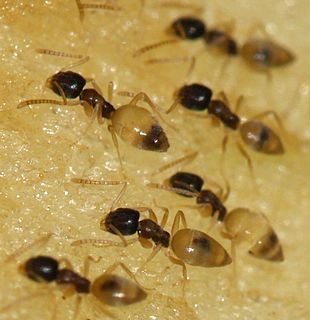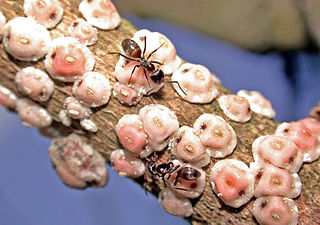
Lasius is a genus of formicine ants. The type species for this genus is the black garden ant, Lasius niger. Other major members, which live in drier heathland, are the cornfield ant, L. neoniger, and L. alienus. Other species include the temporary social parasites of the L. mixtus group and the hyper-social parasite Lasius fuliginosus. Lasius flavus is also a commonly seen species, building grassy hillocks in undisturbed pasture. In the Alps, these mounds - always aligned east to catch the first rays of the rising sun - have been traditionally used by goatherds as natural compasses. Species in the subgenus Acanthomyops, in particular L. interjectus and L. claviger, are commonly known as citronella ants due to their citronella-like smell.

Messor is a myrmicine genus of ants with more than 100 species, all of which are harvester ants; the generic name comes from the Roman god of crops and harvest, Messor. The subterranean colonies tend to be found in open fields and near roadsides, openings are directly to the surface.

Myrmicinae is a subfamily of ants, with about 140 extant genera; their distribution is cosmopolitan. The pupae lack cocoons. Some species retain a functional sting. The petioles of Myrmicinae consist of two nodes. The nests are permanent and in soil, rotting wood, under stones, or in trees.

Tapinoma is a genus of ants that belongs to the subfamily Dolichoderinae. The genus currently comprises 74 described species distributed worldwide in tropical and temperate regions. Members of are generalized foragers, nesting in a wide variety of habitats, ranging from grasslands, open fields, woodlands, to inside buildings. The majority of species nest in the ground under objects such as stones or tree logs, other species build nests under bark of logs and stumps, in plant cavities, insect galls or refuse piles.

Dorymyrmex is a genus of ants in the subfamily Dolichoderinae.

Aphaenogaster is a genus of myrmicine ants. About 200 species have been described, including 18 fossil species. They occur worldwide except in South America south of Colombia, sub-Saharan Africa, and Antarctica.

Cataglyphis is a genus of ant, desert ants, in the subfamily Formicinae. Its most famous species is C. bicolor, the Sahara Desert ant, which runs on hot sand to find insects that died of heat exhaustion, and can, like other several other Cataglyphis species, sustain body temperatures up to 50°C. Cataglyphis is also the name of an autonomous rover that won the NASA Sample Return Robot Centennial Challenge inspired by the navigation approaches used by desert ants.

Crematogaster is an ecologically diverse genus of ants found worldwide, which are characterised by a distinctive heart-shaped gaster (abdomen), which gives them one of their common names, the Saint Valentine ant. Members of this genus are also known as cocktail ants because of their habit of raising their abdomens when alarmed. Most species are arboreal. These ants are sometimes known as acrobat ants.

Pseudomyrmex is a genus of stinging, wasp-like ants in the subfamily Pseudomyrmecinae. They are large-eyed, slender ants, found mainly in tropical and subtropical regions of the New World.

Hypoponera is a genus of ants in the subfamily Ponerinae. The genus has a worldwide distribution and is found in all continents except Antarctica.

Forelius is a Neotropical genus of ants in the subfamily Dolichoderinae. The genus is known from southern United States to Argentina.

Neivamyrmex is a genus of army ants in the subfamily Dorylinae.

Carebara is a genus of ants in the subfamily Myrmicinae. It is one of the largest myrmicine genera with more than 200 species distributed worldwide in the tropics and the Afrotropical region. Many of them are very tiny cryptic soil and leaf litter inhabitants. They nest in rotten wood to which the bark is still adherent in the Afrotropical region, or may be lestobiotic nesting near other ant species. Some species are known to exist parasitically within termite nests. Little is known about the biology of the species. However, they are notable for the vast difference in size between queens and workers.

Myrmelachista is a Neotropical genus of ants in the subfamily Formicinae. The genus is found exclusively in the Neotropical realm. Little is known regarding their biology.

Pseudolasius is a genus of ants in the subfamily Formicinae. The genus is known from southern Asia to northern Australia, where it appears to be restricted to tropical areas.

Zasphinctus is a genus of ants in the subfamily Dorylinae. The genus is a pantropical and distinctive group, originally described by Wheeler (1918) based on "Sphinctomyrmex" turneri collected in Queensland, Australia. Zasphinctus was first described as a subgenus of "Eusphinctus", and then synonymized into Sphinctomyrmex, to later be raised to full genus status by Borowiec (2016), who included approximately 20 species in the new genus circumscription.

Lioponera is a genus of ants in the subfamily Dorylinae containing approximately 74 described species. The genus is distributed widely across the Afrotropical, Australasia, Indomalaya, Malagasy, and Palearctic bioregions. Lioponera was described by Mayr (1879) and later placed as a junior synonym of Cerapachys by Brown (1975). Lioponera was resurrected as a valid genus by Borowiec (2016) during redescription of the doryline genera.
Bothriomyrmex corsicus is a species of ant in the genus Bothriomyrmex. Described by Santschi in 1923, the species is endemic to various European countries, including Austria, Bulgaria, Czech Republic, France, Greece, Hungary, Italy, Liechtenstein, Monaco, Montenegro, Romania, Serbia, Slovakia, Slovenia, Spain, Switzerland, Turkey, Ukraine.

















